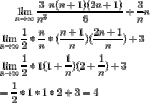pipsydoodles
New member
- Joined
- Jan 4, 2018
- Messages
- 2
The example is as follows:
. . .\(\displaystyle \displaystyle \lim_{n \rightarrow \infty} \dfrac{3}{n^3}\, \dfrac{n\, (n\, +\, 1)\, (2n\, +\, 1)}{6}\, +\, \dfrac{3}{n}\, n\)
. . .\(\displaystyle \displaystyle \lim_{n \rightarrow \infty} \dfrac{1}{2}\, \cdot\, \dfrac{n}{n}\, \cdot\, \left(\dfrac{n\, +\, 1}{n}\right)\, \left(\dfrac{2n\, +\, 1}{n}\right)\, +\, 3\)
. . .\(\displaystyle \displaystyle \lim_{n \rightarrow \infty} \dfrac{1}{2}\, \cdot\, 1\, \left(1\, +\, \dfrac{1}{n}\right)\, \left(2\, +\, \dfrac{1}{n}\right)\, +\, 3\)
. . . . . . . . . .\(\displaystyle \displaystyle =\, \dfrac{1}{2}\, \cdot\, 1\, \cdot\, 1\, \cdot\, 2\, +\, 3\, =\, 4\)
Where I start to get confused is on the second line as it appears that some intermediary steps were skipped for brevity. Normally, I would have solved the question like so:
. . .\(\displaystyle \displaystyle \lim_{n \rightarrow \infty} \dfrac{3}{n^3}\, \dfrac{n\, (n\, +\, 1)\, (2n\, +\, 1)}{6}\, +\, \dfrac{3}{n}\, n\)
. . .\(\displaystyle \displaystyle \lim_{n \rightarrow \infty} \dfrac{1}{2}\, \cdot\, \dfrac{1}{n^3}\, \cdot\, \left(2n^3\, +\, 3n^2\, +\, n\right)\, +\, 3\)
. . .\(\displaystyle \displaystyle \lim_{n \rightarrow \infty} \dfrac{1}{2}\, \cdot\, \left(2\, +\, \dfrac{3}{n}\, +\, \dfrac{1}{n^2}\right)\, +\, 3\)
. . . . . . . . . .\(\displaystyle \displaystyle =\, \dfrac{1}{2}\, \cdot\, 2\, +\, 3\, =\, 4\)
so trying to understand the question from a different perspective would be quite useful to me.
. . .\(\displaystyle \displaystyle \lim_{n \rightarrow \infty} \dfrac{3}{n^3}\, \dfrac{n\, (n\, +\, 1)\, (2n\, +\, 1)}{6}\, +\, \dfrac{3}{n}\, n\)
. . .\(\displaystyle \displaystyle \lim_{n \rightarrow \infty} \dfrac{1}{2}\, \cdot\, \dfrac{n}{n}\, \cdot\, \left(\dfrac{n\, +\, 1}{n}\right)\, \left(\dfrac{2n\, +\, 1}{n}\right)\, +\, 3\)
. . .\(\displaystyle \displaystyle \lim_{n \rightarrow \infty} \dfrac{1}{2}\, \cdot\, 1\, \left(1\, +\, \dfrac{1}{n}\right)\, \left(2\, +\, \dfrac{1}{n}\right)\, +\, 3\)
. . . . . . . . . .\(\displaystyle \displaystyle =\, \dfrac{1}{2}\, \cdot\, 1\, \cdot\, 1\, \cdot\, 2\, +\, 3\, =\, 4\)
Where I start to get confused is on the second line as it appears that some intermediary steps were skipped for brevity. Normally, I would have solved the question like so:
. . .\(\displaystyle \displaystyle \lim_{n \rightarrow \infty} \dfrac{3}{n^3}\, \dfrac{n\, (n\, +\, 1)\, (2n\, +\, 1)}{6}\, +\, \dfrac{3}{n}\, n\)
. . .\(\displaystyle \displaystyle \lim_{n \rightarrow \infty} \dfrac{1}{2}\, \cdot\, \dfrac{1}{n^3}\, \cdot\, \left(2n^3\, +\, 3n^2\, +\, n\right)\, +\, 3\)
. . .\(\displaystyle \displaystyle \lim_{n \rightarrow \infty} \dfrac{1}{2}\, \cdot\, \left(2\, +\, \dfrac{3}{n}\, +\, \dfrac{1}{n^2}\right)\, +\, 3\)
. . . . . . . . . .\(\displaystyle \displaystyle =\, \dfrac{1}{2}\, \cdot\, 2\, +\, 3\, =\, 4\)
so trying to understand the question from a different perspective would be quite useful to me.
Attachments
Last edited by a moderator:


